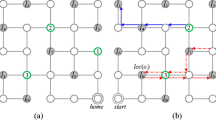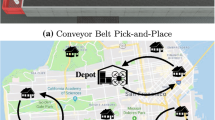Abstract
Multi-robot patrolling is a key feature for various applications related to surveillance and security, and it has been studied from several different perspectives, ranging from techniques that devise optimal off-line strategies to implemented systems. However, still few approaches consider on-line decision techniques that can cope with uncertainty and non-determinism in robot behaviors. In this article we address on-line coordination, by casting the multi-robot patrolling problem as a task assignment problem and proposing two solution techniques: DTA-Greedy, which is a baseline greedy approach, and DTAP, which is based on sequential single-item auctions. We evaluate the performance of our system in a realistic simulation environment (built with ROS and stage) as well as on real robotic platforms. In particular, in the simulated environment we compare our task assignment approaches with previous off-line and on-line methods. Our results confirm that on-line coordination approaches improve the performance of the multi-robot patrolling system in real environments, and that coordination approaches that employ more informed coordination protocols (e.g., DTAP) achieve better performances with respect to state-of-the-art online approaches (e.g., SEBS) in scenarios where interferences among robots are likely to occur. Moreover, the deployment on real platforms (three Turtlebots in an office environment) shows that our on-line approaches can successfully coordinate the robots achieving good patrolling behaviors when facing typical uncertainty and noise (e.g., localization and navigation errors) associated to real platforms.












Similar content being viewed by others
Notes
The simulator was originally developed by David Portugal and has been used to compare patrolling strategies in previous work (e.g., Portugal and Rocha 2013a). We modified the simulator to include our DTA approaches and to improve the behaviours of the robots for providing more realistic simulations. The current version of the simulator is available at wiki.ros.org/patrolling_sim.
Frequency is the inverse of idleness, thus results based on idleness can be directly related to frequency.
In the experiments we used a delay of 0.2 s for each message.
References
Agmon, N. (2010). On events in multi-robot patrol in adversarial environments. In Proceedings of international joint conference on autonomous agents and multi-agent systems (AAMAS).
Agmon, N., Fok, C. L., Emaliah, Y., Stone, P., Julien, C., & Vishwanath, S. (2012). On coordination in practical multi-robot patrol. In IEEE international conference on robotics and automation (ICRA).
Agmon, N., Urieli, D., & Stone, P. (2011). Multiagent patrol generalized to complex environmental conditions. In Proceedings of the twenty-fifth conference on artificial intelligence. http://www.cs.utexas.edu/users/ai-lab/pub-view.php?PubID=127070.
Ahmadi, M., & Stone, P. (2006). A multi-robot system for continuous area sweeping tasks. In Proceedings of the IEEE international conference on robotics and automation (pp. 1724–1729). http://www.cs.utexas.edu/users/ai-lab/pub-view.php?PubID=126653.
Almeida, A., Ramalho, G., Santana, H., Tedesco, P. A., Menezes, T., Corruble, V., et al. (2004). Recent advances on multi-agent patrolling. In Advances in artificial intelligence—SBIA 2004: 17th Brazilian symposium on artificial intelligence
Basilico, N., Gatti, N., & Villa, F. (2010). Asynchronous multi-robot patrolling against intrusion in arbitrary topologies. In Proceedings of the AAAI conference on artificial intelligence (AAAI), Atlanta (pp. 1124–1229).
Batalin, M. A., & Sukhatme, G. S. (2002). Spreading out: A local approach to multi-robot coverage. In Distributed autonomous robotic systems 5 (pp. 373–382). Tokyo: Springer
Burgard, W., Moors, M., Stachniss, C., & Schneider, F. E. (2005). Coordinated multi-robot exploration. IEEE Transactions on Robotics, 21(3), 376–386.
Chevaleyre, Y. (2004). Theoretical analysis of the multi-agent patrolling problem. In Proceedings of IEEE/WIC/ACM international conference on intelligent agent technology. New York: IEEE Computer Society.
Elmaliach, Y., Agmon, N., & Kaminka, G. (2007). Multi-robot area patrol under frequency constraint. In Proceedings of the IEEE international conference on robotics and automation (ICRA).
Elmaliach, Y., Agmon, N., & Kaminka, G. (2009). Multi-robot area patrol under frequency constraints. Annals of Mathematics and Artificial Intelligence, 57, 293–320.
Elmaliach, Y., Shiloni, A., & Kaminka, G. A. (2008). A realistic model of frequency-based multi-robot polyline patrolling. In Proceedings of international joint conference on autonomous agents and multi-agent systems (AAMAS).
Holz, D., Basilico, N., Amigoni, F., & Behnke, S. (2011). A comparative evaluation of exploration strategies and heuristics to improve them. In Proceedings of the 4th European conference on mobile robots (ECMR) (pp. 25–30).
Iocchi, L., Marchetti, L., & Nardi, D. (2011). Multi-robot patrolling with coordinated behaviours in realistic environments. In Proceedings of the international conference on intelligent robots and systems (IROS) (pp. 2796–2801). doi:10.1109/IROS.2011.6094844.
Machado, A., Ramalho, G., Zucker, J. D., & Drogoul, A. (2003). Multi-agent patrolling: An empirical analysis of alternative architectures. In Proceedings of the 3rd international conference on multi-agent-based simulation II, Berlin.
Marier, J. S., Besse, C., & Chaib-draa, B. (2010). Solving the continuous time multiagent patrol problem. In 2010 IEEE international conference on robotics and automation (ICRA) (pp. 941–946).
Marino, A., Parker, L., Antonelli, G., & Caccavale, F. (2009). Behavioral control for multi-robot perimeter patrol: A finite state automata approach. In Proceedings of the 2009 IEEE international conference on robotics and automation.
Pippin, C., Christensen, H., & Weiss, L. (2013). Performance based task assignment in multi-robot patrolling. In Proceedings of the 28th annual ACM symposium on applied computing, SAC ’13 (pp. 70–76). New York: ACM. doi:10.1145/2480362.2480378.
Portugal, D., Couceiro, M. S., & Rocha, R. P. (2013). Applying bayesian learning to multi-robot patrol. In Proceedings of IEEE international symposium on safety, security, and rescue robotics (SSRR) (pp. 1–6). doi:10.1109/SSRR.2013.6719325.
Portugal, D., & Rocha, R. (2010). MSP algorithm: Multi-robot patrolling based on territory allocation using balanced graph partitioning. In Proceedings of the 2010 ACM symposium on applied computing.
Portugal, D., & Rocha, R. P. (2011). On the performance and scalability of multi-robot patrolling algorithms. In 2011 IEEE international symposium on safety, security, and rescue robotics (SSRR) (pp. 50–55). doi:10.1109/SSRR.2011.6106761.
Portugal, D., & Rocha, R. P. (2013). Distributed multi-robot patrol: A scalable and fault-tolerant framework. Robotics and Autonomous Systems, 61, 1572–1587.
Portugal, D., & Rocha, R. P. (2013). Multi-robot patrolling algorithms: Examining performance and scalability. Advanced Robotics, 27(5), 325–336.
Santana, H., Ramalho, G., Corruble, V., & Ratitch, B. (2004). Multi-agent patrolling with reinforcement learning. In Proceedings of the third international joint conference on autonomous agents and multiagent systems, AAMAS ’04 (Vol. 3, pp. 1122–1129).
Sempé, F., & Drogoul, A. (2003). Adaptive patrol for a group of robots. In Proceedings of IEEE/RSJ international conference on intelligent robots and systems (IROS) (pp. 2865–2869).
Stranders, R., de Cote, E. M., Rogers, A., & Jennings, N. (2013). Near-optimal continuous patrolling with teams of mobile information gathering agents. Artificial Intelligence, 195, 63–105. doi:10.1016/j.artint.2012.10.006. http://www.sciencedirect.com/science/article/pii/S0004370212001282.
Tovey, C., Lagoudakis, M., Jain, S., & Koenig, S. (2005). The generation of bidding rules for auction-based robot coordination. In Multi-robot systems: From swarms to intelligent automata (Vol. 3, pp. 3–14). Berlin: Springer.
Author information
Authors and Affiliations
Corresponding author
Electronic supplementary material
Below is the link to the electronic supplementary material.
Rights and permissions
About this article
Cite this article
Farinelli, A., Iocchi, L. & Nardi, D. Distributed on-line dynamic task assignment for multi-robot patrolling. Auton Robot 41, 1321–1345 (2017). https://doi.org/10.1007/s10514-016-9579-8
Received:
Accepted:
Published:
Issue Date:
DOI: https://doi.org/10.1007/s10514-016-9579-8




